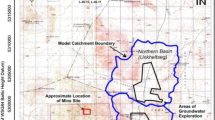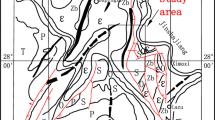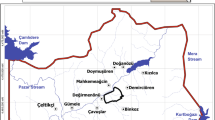Abstract
Grout curtains are often used to manage lateral water inflow. However, grout curtains constructed in extremely fractured rocks are not very effective, which poses a challenge for mine drainage and mining operations. So, it is crucial to consider the curtain’s effectiveness when evaluating water inflow. Large-scale pumping tests and groundwater numerical simulation were used in this study to evaluate the water inflow at an iron mine surrounded by an imperfect grout curtain. The effectiveness of the curtain was determined by comparing the hydraulic differences on both sides of the curtain and flow fields at pre- and post-grouting stages and three preferential seepage paths were identified. Given the mine’s complex boundary conditions, the telescopic mesh refinement modeling method was used; regional and local models were established using FEFLOW. The predicted inflow due to the gap in the curtain was 13,880 m3/day, accounting for 37.1% of the total 37,340 m3/day of water that still flowed into the mine. Two countermeasures, surface curtain remediation and underground grouting, were used to decrease water inflow and restore mine productivity.
Zusammenfassung
Dichtungsschleier werden häufig eingebaut, um den lateralen Wasserzustrom zu steuern. Allerdings sind Dichtungsschleier, die in extrem zerklüftetem Gestein errichtet wurden, nicht sehr effektiv, was eine Herausforderung für die Grubenentwässerung und den Bergbaubetrieb darstellt. Daher ist es wichtig, die Effektivität des Schleiers bei der Bewertung des Wasserzustroms zu berücksichtigen. In dieser Studie wurden großmaßstäbliche Pumpversuche und numerische Grundwassersimulationen eingesetzt, um den Wasserzufluss in einer Eisenmine zu bewerten, die von einem unvollkommenen Dichtungsschleier umschlossen ist. Die Effektivität des Schleiers wurde durch den Vergleich der hydraulischen Druckdifferenzen auf beiden Seiten des Schleiers und der Strömungsfelder vor und nach der Abdichtung ermittelt, und es wurden drei bevorzugte Sickerpfade identifiziert. Angesichts der komplexen Randbedingungen des Bergwerks wurde die Modellierungsmethode der teleskopischen Netzverfeinerung verwendet; regionale und lokale Modelle wurden mit FEFLOW erstellt. Der vorhergesagte Zufluss aufgrund der Lücke im Schleier betrug 13.880 m3/d, was 37,1 % der insgesamt 37.340 m3/d Wasser ausmachte, die noch in die Mine flossen. Zwei Gegenmaßnahmen wurden eingesetzt, um den Wasserzufluss zu verringern und die Produktivität der Mine wiederherzustellen: die Sanierung des Oberflächenschleiers und das Verpressen unter Tage.
Resumen
Las cortinas de lechada se utilizan frecuentemente para evitar la entrada de agua lateral. Sin embargo, las cortinas de lechada construidas en rocas extremadamente fracturadas no son muy eficaces, lo que plantea un desafío para el drenaje de las minas y las operaciones mineras. Por lo tanto, es crucial considerar la efectividad de la cortina cuando se evalúa la irrupción de agua. En este estudio se utilizaron pruebas de bombeo a gran escala y simulación numérica de aguas subterráneas para evaluar la irrupción de agua en una mina de hierro rodeada por una cortina de lechada imperfecta. La eficacia de la cortina se determinó comparando las diferencias hidráulicas a ambos lados de la cortina y los campos de flujo en las etapas previas y posteriores a la lechada y se identificaron tres vías de filtración principales. Dadas las complejas condiciones de los límites de la mina, se utilizó el método de modelación del refinamiento de la malla telescópica; se establecieron modelos regionales y locales utilizando FEFLOW. El caudal previsto debido a la brecha en la cortina fue de 13.880 m3/d, lo que representa el 37,1% del total de 37.340 m3/d de agua que aún fluía en la mina. Se utilizaron dos contramedidas, la remediación de la cortina de superficie y la lechada subterránea, para disminuir la entrada de agua y restaurar la productividad de la mina.
缺陷注浆帷幕内铁矿的地下水涌水量预测
注浆帷幕常用以控制侧向地下水流。但是,建立在极破碎围岩内的注浆帷幕可能不完全有效,仍会给矿山排水和采矿带来安全挑战。因此,涌水量评价时,考虑注浆帷幕效果致关重要。研究采用了大规模抽水试验和地下水数值模拟方法预测帷幕存在缺陷的铁矿的涌水量。通过对比帷幕两侧水力差异和注浆前后流场变化,评价了注浆帷幕效果,识别出三条优先流路径。考虑矿井边界条件复杂,采用伸缩网格细化法(TMR),建立了区域和局部FEFLOW地下水流模型。预测穿过帷幕间隙的涌水量13 880 m3/d,占现汇入矿井总涌水量37 340 m3/d的37.1%。采取了地表帷幕整治和井下注浆两种措施减少涌水量和恢复生产。












Similar content being viewed by others

References
Anderson MP, Woessner WW, Hunt RJ (2015) Applied groundwater modeling: simulation of flow and advective transport. Academic Press
ASTM (International) (2008) Standard guide for calibrating a groundwater flow model application D5981-96. American Society of Testing and Materials. ASTM International
Battaglia D, Birindelli F, Rinaldi M, Vettraino E, Bezzi A (2016) Fluorescent tracer tests for detection of dam leakages: the case of the Bumbuna dam Sierra Leone. Eng Geol 205:30–39
Candeias C, Ávila PF, Ferreira SE, Paulo JT (2015) Integrated approach to assess the environmental impact of mining activities: estimation of the spatial distribution of soil contamination (Panasqueira mining area, central Portugal). Environ Monit Assess 187(3):135–158
Carter TG, Dershowitz W (2012) Improved methods of design for grouting fractured rock. In: Grouting and deep mixing, geotechnical special publications (GSP), vol 28, pp 1472–1483
Chen WC, Li WP, Qiao W, Li LF (2020) Beneficial use of deep ordovician limestone water from mine safety dewatering at the Xinglongzhuang coal mine, north China. Mine Water Environ 39:42–56
Cooper HH, Jacob CE (1946) A generalized graphical method for evaluating formation constants and summarizing well-field history. Eos Trans AGU 27(4):526–534
Davis GM, Horswill P (2002) Groundwater control and stability in an excavation in a magnesian limestone near Sunderland, NE England. Eng Geol 66(1):1–18
DHI-WASY (2017) FEFLOW 7.1 User Manual. DHI-WASY GmbH, Berlin Germany. http://www.feflow.com/uploads/media/users_manual71.pdf. Accessed 5 Mar 2020
Dong D, Sun W, Xi S (2012) Optimization of mine drainage capacity using FEFLOW for the no. 14 coal seam of China’s Linnancang coal mine. Mine Water Environ 31:353–360
DZ/T 0285 (2015) Technical guide for mine grout curtains in China. Standards Press of China, Beijing (in Chinese)
Guo JF (2005) Problems in exploitation of China complicated hard to mine ore deposit and countermeasures. Met Mine 12:10–13 ((in Chinese))
He K, Wang R, Jiang WF (2012) Groundwater inrush channel detection and curtain grouting of the Gaoyang iron ore mine. China Mine Water Environ 31(4):297–306
Hu YB, Li WP, Wang QQ, Liu SL, Wang ZK (2019) Evaluation of water inrush risk from coal seam floors with an AHP-EWM algorithm and GIS. Environ Earth Sci 78:290–305
Huang F, Wang GH, Yang YY, Wang CB (2014) Overexploitation status of groundwater and induced geological hazards in China. Nat Hazards 73:727–741
Hunt RJ, Steuer JJ, Mansor MTC, Bullen TD (2001) Delineating a recharge area for a spring using numerical modeling, Monte Carlo techniques, and geochemical investigation. Groundwater 39(5):702–712
Leake SA, Claar DV (1999) Procedures and computer programs for telescopic mesh refinement using MODFLOW. Geol Surv Open File Rep, U.S. https://doi.org/10.3133/ofr99238
Liu SL, Li WP (2019) Indicators sensitivity analysis for environmental engineering geological patterns caused by underground coal mining with integrating variable weight theory and improved matter-element extension model. Sci Total Environ 686:606–618
Liu SL, Li WP, Qi W, Li XQ, Wang QQ, He JH (2019) Zoning method for mining-induced environmental engineering geological patterns considering the degree of influence of mining activities on phreatic aquifer. J Hydrol 578:124720
Medeiros WE, Nascimento AFD, Silva FCA, Destro N, Demétrio JGA (2010) Evidence of hydraulic connectivity across deformation bands from field pumping tests: two examples from Tucano Basin, NE Brazil. J Struct Geol 32(11):1783–1791
Mendecki AJ (1997) Seismic monitoring in mines. Chapman & Hall, London
Morris MD (1991) Factorial sampling plans for preliminary computational experiments. Technometrics 33(2):161–174
Murray Darling Basin Commission (MDBC) (2001) Groundwater flow modeling guideline. Report prepared by Aquaterra
Qiao W, Li WP, Li T, Chang JY, Wang QQ (2017) Effects of coal mining on shallow water resources in semiarid regions: a case study in the Shennan mining area, Shaanxi, China. Mine Water Environ 36:104–113
Ta D, Cao S, Steyl G, Yang HY, Li Y (2019) Prediction of groundwater inflow into an iron mine: a case study of the Thach Khe iron mine, Vietnam. Mine Water Environ 38(2):310–324
Theis CV (1935) The relation between the lowering of the piezometric surface and the rate and duration of discharge of a well using groundwater storage. Eos Trans AGU 16(2):519–524
Tzampoglou P, Loupasakis C (2018) Evaluating geological and geotechnical data for the study of land subsidence phenomena at the perimeter of the Amyntaio coalmine, Greece. Int J Min Sci Technol 28:601–612
Wang J, Liu X, Wu YB, Liu SL, Wu LG, Lou RX, Lu JS, Yin Y (2017) Field experiment and numerical simulation of coupling non-Darcy flow caused by curtain and pumping well in foundation pit dewatering. J Hydrol 549:277–293
Ward DS, Buss DR, Mercer JW, Hughes SS (1987) Evaluation of a groundwater corrective action at the Chem-Dyne hazardous waste site using a telescopic mesh refinement modeling approach. Water Resour Res 23(4):603–617
Wu Q, Liu YZ, Wu XL, Liu SQ, Sun WJ, Zeng YF (2016) Assessment of groundwater inrush from underlying aquifers in Tunbai coal mine, Shanxi province, China. Environ Earth Sci 75:737–750
Wu Q, Guo XM, Shen JJ, Xu S, Liu SQ, Zeng YF (2017) Risk assessment of water inrush from aquifers underlying the Gushuyuan coal mine, China. Mine Water Environ 36:96–103
Xue S, Liu Y, Liu S, Li WP, Wu YL, Pei YB (2018) Numerical simulation for groundwater distribution after mining in Zhuanlongwan mining area based on visual MODFLOW. Environ Earth Sci 77:400–409
Yang Z, Li WP, Li XQ, He JH (2019) Quantitative analysis of the relationship between vegetation and groundwater buried depth: a case study of a coal mine district in Western China. Ecol Indic 102:770–782
Zhang GL, Zhan KY, Sui WH (2011) Experimental investigation of the impact of flow velocity on grout propagation during chemical grouting into a fracture with flowing water. J China Coal Soc 36:403–406 ((in Chinese))
Zhang P, Yang T, Yu QL, Xu T, Shi WH, Li SC (2016) Study of a seepage channel formation using the combination of microseismic monitoring technique and numerical method in Zhangmatun iron mine. Rock Mech Rock Eng 49(9):3699–3708
Zhao CH (2013) Analysis on local and overall sensitivity of high pressurized hydrological parameters of aquifer. Coal Sci Technol 41(8):110–113
Zhou N, Vermeer PA, Lou RX, Tang YQ, Jang SM (2010) Numerical simulation of deep foundation pit dewatering and optimization of controlling land subsidence. Eng Geol 114(3–4):251–260
Acknowledgements
Financial support for this work was provided by the Fundamental Research Funds of the State Key Program of National Natural Science of China (Grant No.41931284), and the National Basic Research Program of China (Grant No.2015CB251601). The authors also thank the reviewers for their useful comments.
Author information
Authors and Affiliations
Corresponding author
Supplementary Information
Below is the link to the electronic supplementary material.
10230_2021_777_MOESM1_ESM.pdf
Supplementary Fig. 1 Vertical structure of pumping holes and observation holes. Notes: The units of casing or borehole diameter are millimeters (mm) (PDF 1839 kb)
Rights and permissions
About this article
Cite this article
Chen, W., Li, W., Wang, Q. et al. Evaluation of Groundwater Inflow into an Iron Mine Surrounded by an Imperfect Grout Curtain. Mine Water Environ 40, 520–538 (2021). https://doi.org/10.1007/s10230-021-00777-z
Received:
Accepted:
Published:
Issue Date:
DOI: https://doi.org/10.1007/s10230-021-00777-z



